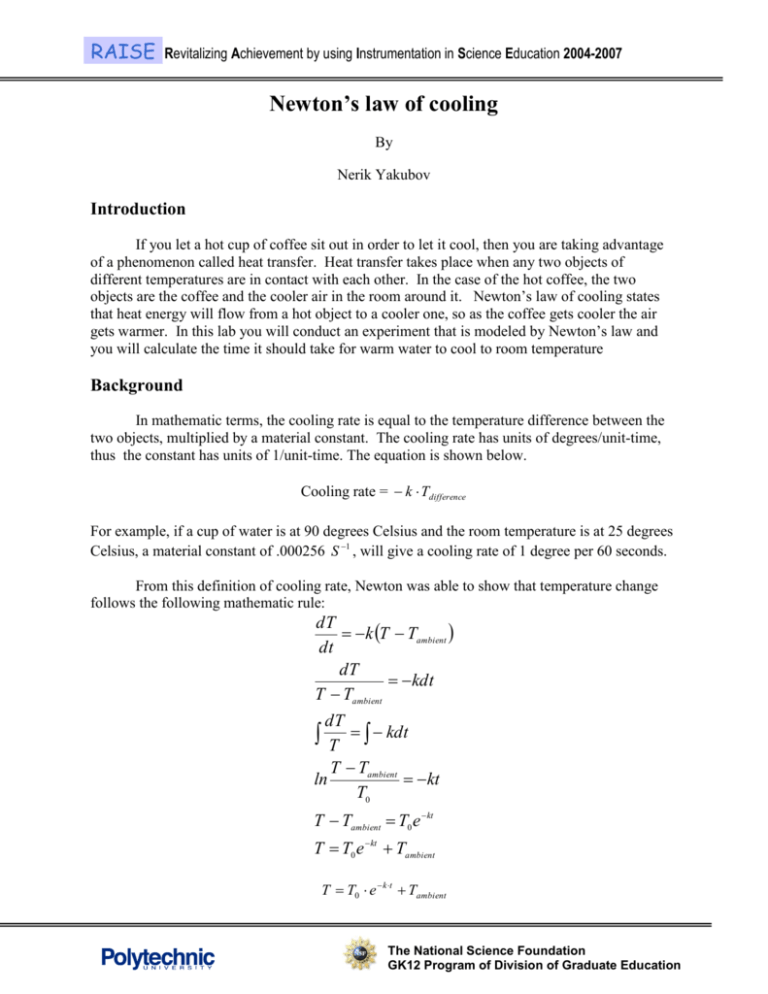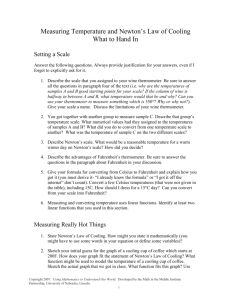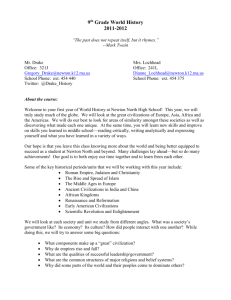Newton`s Law of Cooling
advertisement

RAISE Revitalizing Achievement by using Instrumentation in Science Education 2004-2007 Newton’s law of cooling By Nerik Yakubov Introduction If you let a hot cup of coffee sit out in order to let it cool, then you are taking advantage of a phenomenon called heat transfer. Heat transfer takes place when any two objects of different temperatures are in contact with each other. In the case of the hot coffee, the two objects are the coffee and the cooler air in the room around it. Newton’s law of cooling states that heat energy will flow from a hot object to a cooler one, so as the coffee gets cooler the air gets warmer. In this lab you will conduct an experiment that is modeled by Newton’s law and you will calculate the time it should take for warm water to cool to room temperature Background In mathematic terms, the cooling rate is equal to the temperature difference between the two objects, multiplied by a material constant. The cooling rate has units of degrees/unit-time, thus the constant has units of 1/unit-time. The equation is shown below. Cooling rate = k Tdifference For example, if a cup of water is at 90 degrees Celsius and the room temperature is at 25 degrees Celsius, a material constant of .000256 S 1 , will give a cooling rate of 1 degree per 60 seconds. From this definition of cooling rate, Newton was able to show that temperature change follows the following mathematic rule: dT k T Tambient dt dT kdt T Tambient dT kdt T T Tambient ln kt T0 T Tambient T0 e kt T T0 e kt Tambient T T0 e k t Tambient The National Science Foundation GK12 Program of Division of Graduate Education RAISE Revitalizing Achievement by using Instrumentation in Science Education 2004-2007 With: T = The water’s temperature at a given time, t T0 The initial temperature difference and Tambient The air temperature Objectives - To gain an understanding of heat transfer, when modeled by Newton’s law - To understand how the different variables affect the cooling rate - To perform a cooling experiment using a temperature sensor and plotting software - To use Newton’s law to predict the water temperature at any time Equipment List Computer Vernier computer interface Logger Pro Software Temperature Probe Container Hot water Experimental Procedure 1. Turn on your computer, plug in the computer interface, load the logger pro software and plug the temperature probe into channel 1 of the interface. The software should automatically open a plot for temperature vs. time. 2. Click on the icon on the menu that looks like a clock, change the sampling time to 25 minutes and the samples per minute to 4. 3. Record the room temperature. Hold the temperature probe in the air, out of direct sunlight and out of any wind. On the top right of the screen it should say what the temperature probe is reading. Wait a little while until the number stops changing too much and record this temperature. Room Temperature =_____ 4. Get some hot water from the faucet, for best results it should be around 60 degrees Celsius (about 150 degrees Fahrenheit). 5. Insert the temperature probe into the container, do your best to get most of it into the water and make sure that it is not touching the sides of the container or the bottom. 6. Wait about 20 seconds for the sensor to become the same temperature as the water. Push collect to begin collecting data for 25 minutes. The National Science Foundation GK12 Program of Division of Graduate Education RAISE Revitalizing Achievement by using Instrumentation in Science Education 2004-2007 Figure 1, a schematic of the experiment. Results Newton’s law of cooling was presented earlier as T T0 e k t Tambient . You should now have a graph on your computer screen that follows a very similar shape. Use the Logger Pro software to fit an exponential curve to the data. To do this, click on the curve fit button, , and choose the Natural Exponential function (y=A*exp(–Ct)+B) from the scrolling list. Click to perform the fit, then click . Figure 2, A sample of a cooling curve with an exponential best fit line. Analysis The National Science Foundation GK12 Program of Division of Graduate Education RAISE Revitalizing Achievement by using Instrumentation in Science Education 2004-2007 1. Using Newton’s Law of cooling, and a value for k of .015, predict what the temperature will be after 10, 15 and 25 minutes. 2. According to Newton’s law, how long will it take for the water to get to 1 degree above room temperature? How long will it take to get to 5 degrees higher than room temperature? Using Newton’s law, show that the water temperature will never go below room temperature. 3. If you were to use a larger value of k, would you expect the water temperature to increase faster or slower? 4. If the initial temperature difference was cut in half, how long will it take to get to 1 degree above room temperature? 5. Car radiators usually have fins made of aluminum so that they can get rid of heat quickly, do you think that aluminum has a high k value or a low one? What uses could you think of for a material that does not get rid of heat quickly? 6. Using your temperature readings from time = 10 minutes, your values for T0 and Tambient , and Newton’s law of cooling, calculate what k is. 7. How do your values for T0 , k, and Tambient compare to the values that the software gives you for A, B and C? What can be possible sources for any differences? What would you change in this experiment in order to help with its accuracy? References [1] K. Appel, J. Gasineau, C. Bakken, and D. Vernier, Physics with Computers, Vernier Software and Technology, Beaverton, Oregon, (2003). [2] P.W. Zitzewitz and R.F. Neff, Merrill Physics Principles and Problems, Glencoe/McGraw-Hill, Westerville, Ohio, (1995). The National Science Foundation GK12 Program of Division of Graduate Education







